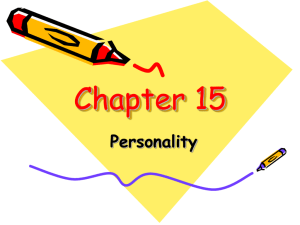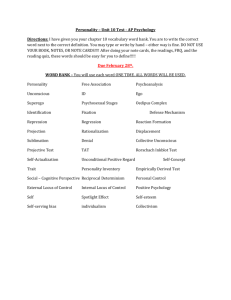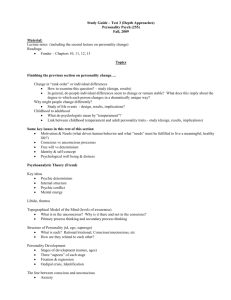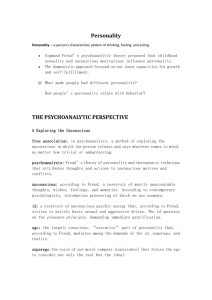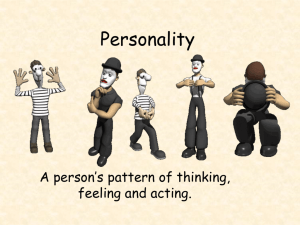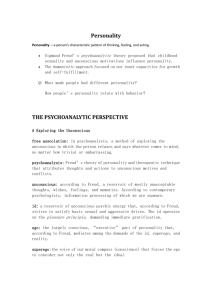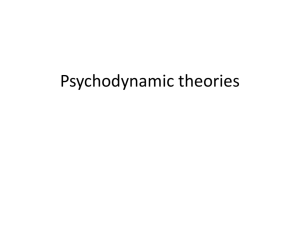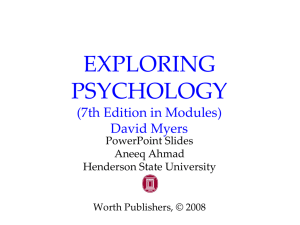File
advertisement
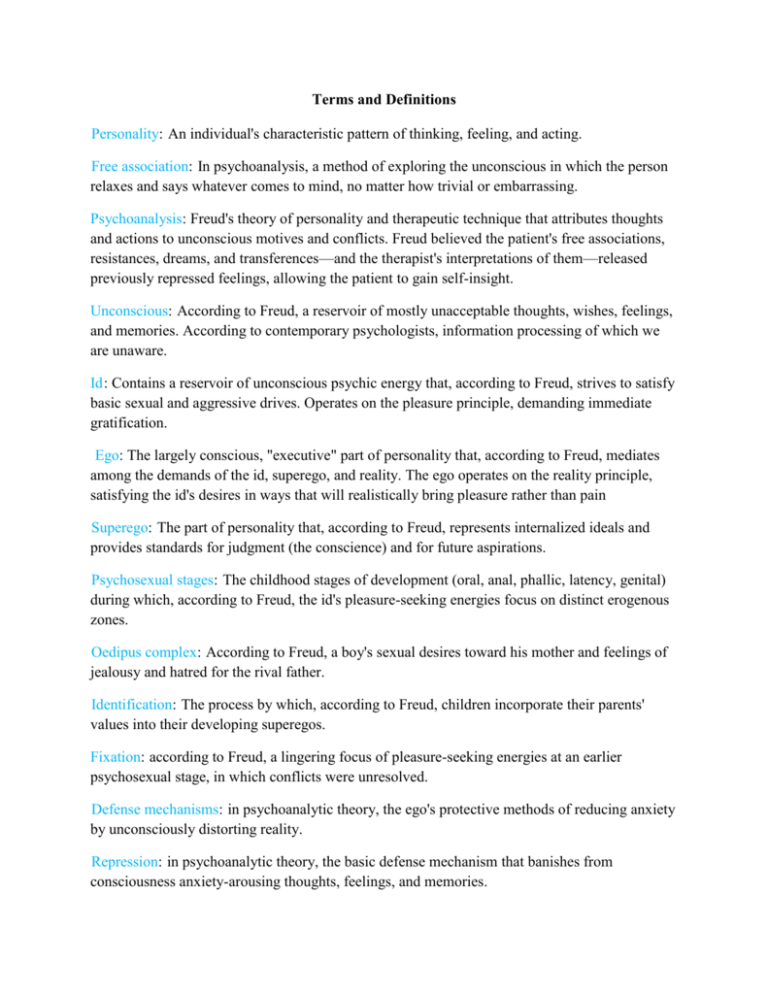
Terms and Definitions Personality: An individual's characteristic pattern of thinking, feeling, and acting. Free association: In psychoanalysis, a method of exploring the unconscious in which the person relaxes and says whatever comes to mind, no matter how trivial or embarrassing. Psychoanalysis: Freud's theory of personality and therapeutic technique that attributes thoughts and actions to unconscious motives and conflicts. Freud believed the patient's free associations, resistances, dreams, and transferences—and the therapist's interpretations of them—released previously repressed feelings, allowing the patient to gain self-insight. Unconscious: According to Freud, a reservoir of mostly unacceptable thoughts, wishes, feelings, and memories. According to contemporary psychologists, information processing of which we are unaware. Id: Contains a reservoir of unconscious psychic energy that, according to Freud, strives to satisfy basic sexual and aggressive drives. Operates on the pleasure principle, demanding immediate gratification. Ego: The largely conscious, "executive" part of personality that, according to Freud, mediates among the demands of the id, superego, and reality. The ego operates on the reality principle, satisfying the id's desires in ways that will realistically bring pleasure rather than pain Superego: The part of personality that, according to Freud, represents internalized ideals and provides standards for judgment (the conscience) and for future aspirations. Psychosexual stages: The childhood stages of development (oral, anal, phallic, latency, genital) during which, according to Freud, the id's pleasure-seeking energies focus on distinct erogenous zones. Oedipus complex: According to Freud, a boy's sexual desires toward his mother and feelings of jealousy and hatred for the rival father. Identification: The process by which, according to Freud, children incorporate their parents' values into their developing superegos. Fixation: according to Freud, a lingering focus of pleasure-seeking energies at an earlier psychosexual stage, in which conflicts were unresolved. Defense mechanisms: in psychoanalytic theory, the ego's protective methods of reducing anxiety by unconsciously distorting reality. Repression: in psychoanalytic theory, the basic defense mechanism that banishes from consciousness anxiety-arousing thoughts, feelings, and memories. Regression: psychoanalytic defense mechanism in which an individual faced with anxiety retreats to a more infantile psychosexual stage, where some psychic energy remains fixated Reaction formation: Psychoanalytic defense mechanism by which the ego unconsciously switches unacceptable impulses into their opposites. Projection: psychoanalytic defense mechanism by which people disguise their own threatening impulses by attributing them to others. Rationalization: Defense mechanism that offers self-justifying explanations in place of the real, more threatening, unconscious reasons for ones actions. Displacement: psychoanalytic defense mechanism that shifts sexual or aggressive impulses toward a more acceptable or less threatening object or person, as when redirecting anger toward a safer outlet. Collective unconscious: Carl Jung's concept of a shared, inherited reservoir of memory traces from our species' history. Projective test: a personality test, such as the Rorschach or TAT, that provides ambiguous stimuli designed to trigger projection of one's inner dynamics. Thematic Apperception test TAT: a projective test in which people express their inner feelings and interests through the stories they make up about ambiguous scenes. Rorschach inkblot test: the most widely used projective test, a set of 10 inkblots, designed by Hermann Rorschach; seeks to identify people's inner feelings by analyzing their interpretations of the blots. Terror-management theory: Proposes that faith in one's worldview and the pursuit of self-esteem provide protection against a deeply rooted fear of death. Self actualization: according to Maslow, the ultimate psychological need that arises after basic physical and psychological needs are met and self-esteem is achieved; the motivation to fulfill one's potential. Unconditional positive regard: according to Rogers, an attitude of total acceptance toward another person. Self-concept: All our thoughts and feelings about ourselves, in answer to the question "who am I?" Trait: a characteristic pattern of behavior or a disposition to feel and act, as assessed by selfreport inventories and peer reports. Personality inventory: A questionnaire on which people respond to items designed to gauge a wide range of feelings and behaviors; used to assess selected personality traits. MMPI: The most widely researched and clinically used of all personality tests - originally designed to identify emotional disorders. Empirically derived test: A test developed by testing a pool of items and then selecting those that discriminate between groups. Social-cognitive perspective: Views behavior as influenced by the interaction between persons and their social context. Reciprocal determinism: The interacting influences between personality and environmental factors. Personal control: Our sense of controlling our environment rather than feeling helpless. External locus of control: The perception that chance or outside forces beyond our personal control determine our fate. Internal locus of control: The belief that an individual has more control over life circumstances than the environment does. Learned helplessness: Lack of motivation to avoid unpleasant stimuli after one has failed before to escape similar stimuli. Positive psychology: A psychology concerned not only with weakness and damage but also with strength and virtue. Spotlight effect: overestimating others' noticing and evaluating our appearance, performance, and blunders. Self-esteem: One's feelings of high or low self-worth. Self-serving bias: A readiness to perceive oneself favorably.


